Red Hat Certified Operator for Spinnaker
Update – Aug 22 2020:
OpsMx Open Enterprise Spinnaker (OES) is now available through the Red Hat Marketplace, an open cloud marketplace that makes it easier to discover and access certified software for container-based environments across the hybrid cloud. Through the marketplace, customers can take advantage of responsive support, streamlined billing and contracting, simplified governance, and single-dashboard visibility across clouds. With automated deployment, software is immediately available to deploy on any Red Hat® OpenShift® cluster, providing a fast, integrated experience. Click the button below for more information, request a trial, or purchase OES from the Red Hat Marketplace.
Spinnaker Lifecycle Management
In this blog we are going to explore the Red Hat Certified Spinnaker Operator to install Red Hat Certified Spinnaker. There are several ways of using the Spinnaker Operator
- OpenShift 4 Certified Operators Marketplace
- Quay, as a Custom Operator
- As a CRD, which omits Operator Lifecycle management
The simplest approach by far is by using the OpenShift 4 Certified Operator Marketplace. When customization or other changes are desired, using the CRD or Quay might be a better fit.
Using the OpenShift 4 Marketplace
The marketplace requires a running OpenShift 4 installation, either use the openshift-installer, the disconnected install guide, or code ready containers. CRC is excellent for testing purposes and is thel most accessible option to work with for small test installs.
Instructions to use Marketplace Operator
- Log into OpenShift with an account that has privileges to install Operators, we’re using kubeadmin on our CRC install because it’s convenient, but would by no means advice anyone to do that on a production system.
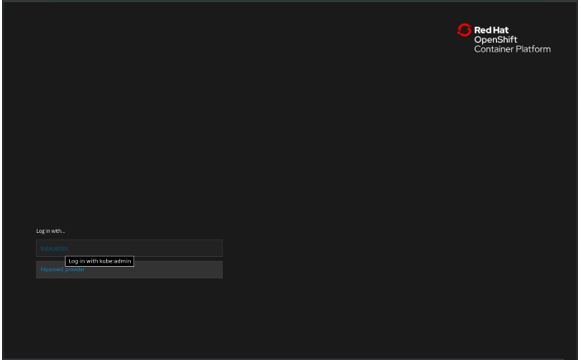
- Go to Operators, OperatoHub, and filter for spinnaker. The community operator as well as the Open Enterprise Spinnaker Operator will show. The Open Enterprise Spinnaker Operator is the only Red Hat Certified Spinnaker, with all containers Red Hat Certified. Click on the Open Enterprise Spinnaker Operator.
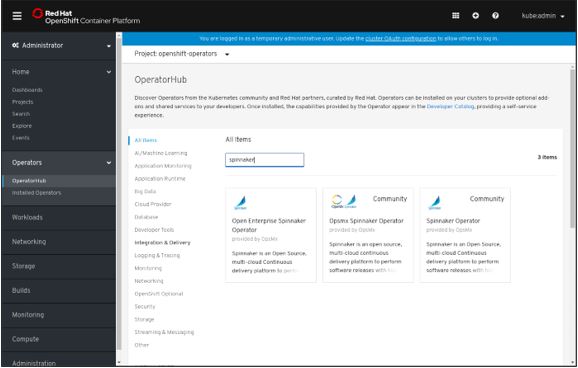
- The brings up the Operator Overview, with its documentation and the install button. Clicking the install button will bring up the create subscription page.
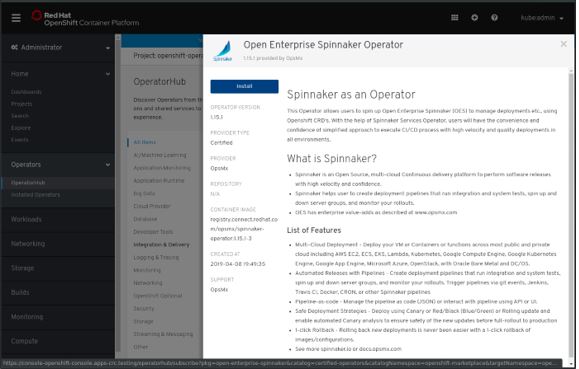
- The Create Operator Subscription is part of the Operator Lifecycle Manager. The OLM framework enables the creator of an operator to update the Operator and offer new functionality, features, and versions to users without users having to lift a finger, when users decide to subscribe to the Automatic Approval Strategy.
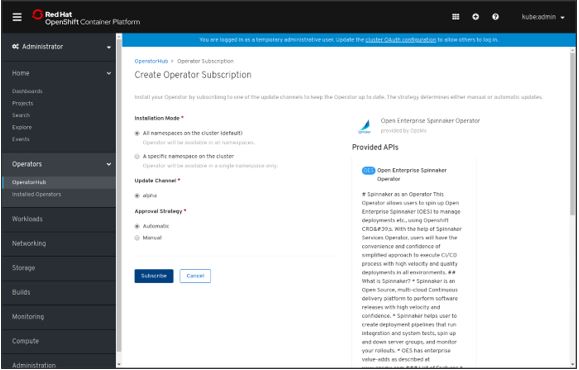
- After clicking Subscribe, the installation automatically redirects to the Installed Operators section, where the status will change with the progress made on installing the Operator. Installation takes a couple of seconds before the status changes to InstallSucceeded as shown below.
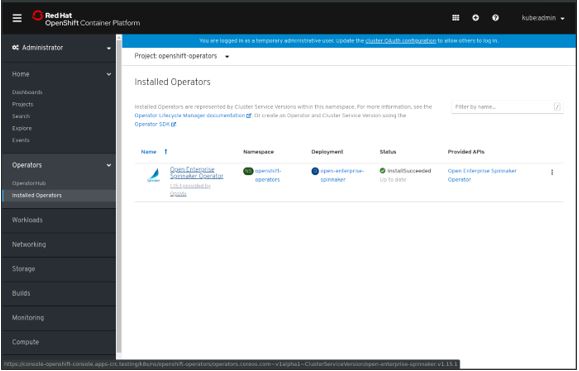
- Behind the scenes, the Operator Framework has set up the OLM Subscription, and the Custom Resource Definition backed by the OES Operator. The installation of the OES Operator pre-creates a Deployment with a Pod that can be used to trigger helm charts which deploy spinnaker based of a configurable manifest.
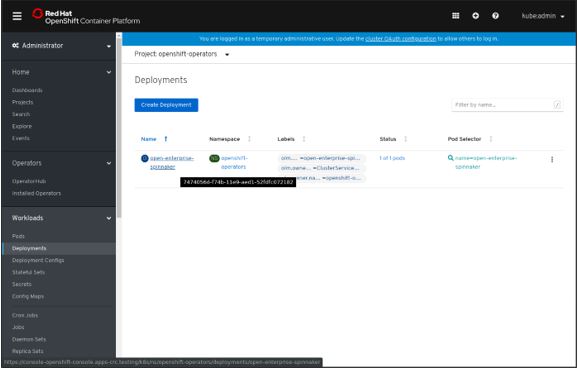
- Going back to the Installed Operators and clicking the Open Enterprise Spinnaker Operator link will pull up the Operator Details page.
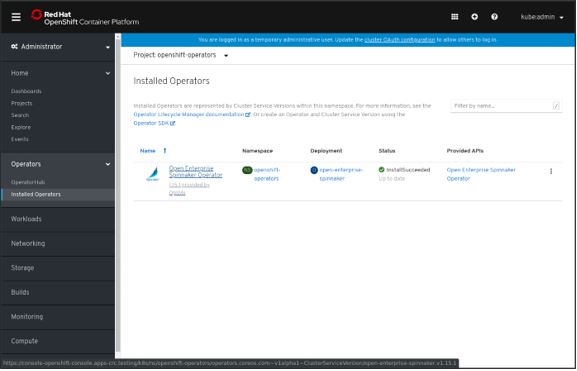
- To create a deployment of Spinnaker, select the Open Enterprise Spinnaker Operator tab and click the Create Open Enterprise Spinnaker Operator button.
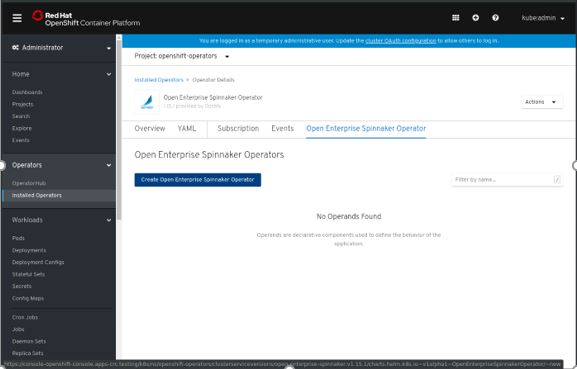
- The YAML on the screen is the actual configuration that gets fed to the CRD’s API endpoint, and gets translated to commands for halyard. The helm charts take care of the translation in the spinnaker-operator pod — the version of the spinnaker-operator container dictates which features are exposed from an operator perspective.
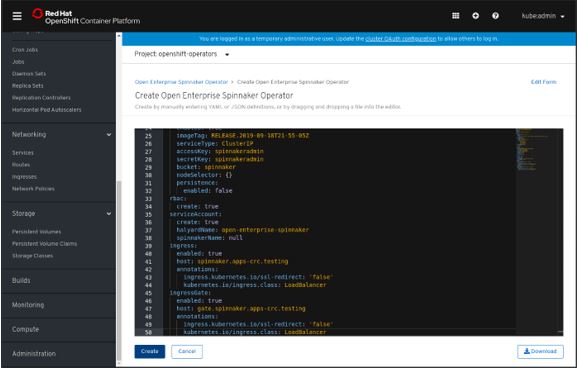
- The default example presented does not expose spinnaker’s UI on a URL. To expose spinnaker’s UI, we can edit the configuration and add an ingress. When using OpenShift 4, the ingress class is LoadBalancer. It is also essential to set the hostname for the ingress correctly. In this example, the host should end in apps-crc.testing, as that is the cluster’s domain name. Below is a sample configuration that leverages the ingress for the UI and the API.
apiVersion: charts.helm.k8s.io/v1alpha1
kind: OpenEnterpriseSpinnakerOperator
metadata:
name: oes
namespace: openshift-operators
spec:
halyard:
spinnakerVersion: 1.17.4
image:
repository: registry.connect.redhat.com/opsmx/ubi8-oes-operator-halyard
tag: 1.17.4-2
dockerRegistries:
- name: dockerhub
address: index.docker.io
repositories:
- library/alpine
- library/ubuntu
- library/centos
- library/nginx
spinnakerFeatureFlags:
- artifacts
- artifacts-rewrite
- chaos
- gremlin
- infrastructure-stages
- mine-canary
- pipeline-templates
- travis
- wercker
- managed-pipeline-templates-v2-ui
minio:
enabled: true
imageTag: RELEASE.2019-09-18T21-55-05Z
serviceType: ClusterIP
accessKey: spinnakeradmin
secretKey: spinnakeradmin
bucket: spinnaker
nodeSelector: {}
persistence:
enabled: false
rbac:
create: false
serviceAccount:
create: false
halyardName: open-enterprise-spinnaker
spinnakerName: null
# The ingress and ingressGate expose the Spinnaker UI (deck) and API (gate).
ingress:
enabled: true
# This is my test hostname, you should use yours.
host: spinnaker.apps-crc.testing
annotations:
ingress.kubernetes.io/ssl-redirect: 'false'
# For OpenShift the class for the ingress should be LoadBalancer.
kubernetes.io/ingress.class: LoadBalancer
ingressGate:
enabled: true
host: gate.spinnaker.apps-crc.testing
annotations:
ingress.kubernetes.io/ssl-redirect: 'false'
kubernetes.io/ingress.class: LoadBalancer
- After adapting the configuration click the create button to deploy spinnaker. For other configuration options the values.yaml in the Github repository is leading.
- Creation of the deployment leads back to the Operator Details. Clicking the deployment’s name there brings up the Operator Overview, where the Resources tab shows the base components for the deployment.
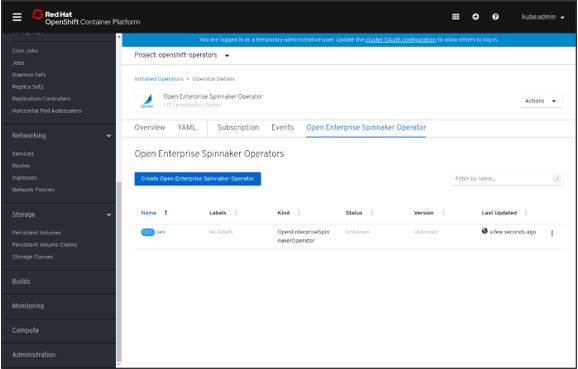
- When deploying the Red Hat Certified Minio, and halyard containers they get pulled into OpenShift from the Red Hat registry. To follow halyard’s progress, the Logs tab in the Pod Details shows the execution flow of the supplied configuration, and subsequently, the creation of the services required for spinnaker. Following the halyard, logs are also possible from the CLI by using either ‘kubectl’ or ‘oc’ with ‘logs -f’ on the halyard Pod.

- If the name serving for OpenShift has been set up correctly in the cluster, and externally, the URL provided in the configuration, http://spinnaker.apps-crc.testing, should initially return an error that the application is not available.

- As soon as several of the containers have spun up, which can be seen in the Pods, Deployments, or Services overview of the namespace, the frontend of Spinnaker becomes available. The initial “Hello!” screen loads and lands on Spinnaker’s search page.
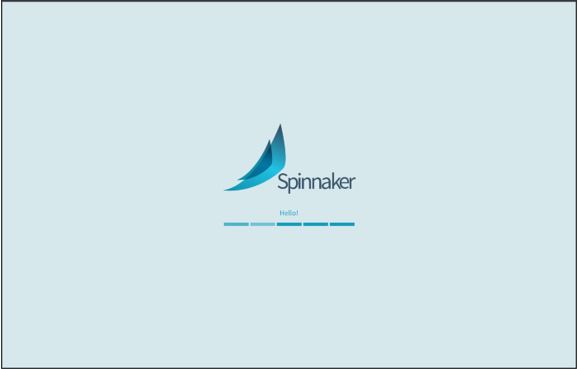
- Generally, Spinnaker Operator deployment process will take couple of minutes time, as some of the services might be configuring depending on the options and the system configuration.
- The search UI will be responsive, as long as the projects and the applications do not load the full stack is not yet done configuring and deploying.
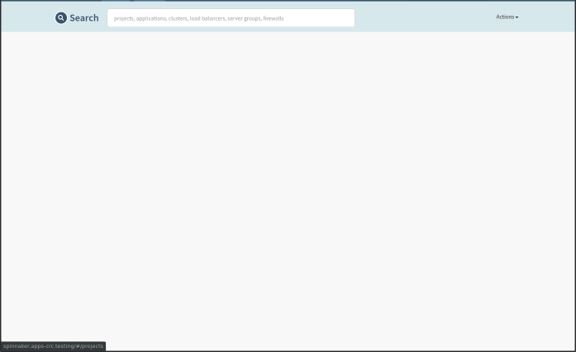

Following this guide on OpenShift 4.2.12 results in the following status:
status:
conditions:
– lastTransitionTime: ‘2020-01-13T15:30:36Z’
status: ‘True’
type: Initialized
– lastTransitionTime: ‘2020-01-13T15:30:39Z’
message: >-
failed to install release: release oes failed: configmaps
“oes-open-enterprise-spin-service-settings” already exists
reason: InstallError
status: ‘True’
type: ReleaseFailed
However, this ConfigMap does not exist. Also, I cannot delete the Operator without manually delete the ‘uninstall-helm-release’-finalizer.
What to do?
Hey Gertjan,
It seems like a recent update and inadequate testing from our side broke the operator, it should be fixed now.
Best,
Funs
Following this guide on OpenShift 4.2.12 results in the following status:
status:
conditions:
– lastTransitionTime: ‘2020-01-13T15:30:36Z’
status: ‘True’
type: Initialized
– lastTransitionTime: ‘2020-01-13T15:30:39Z’
message: >-
failed to install release: release oes failed: configmaps
“oes-open-enterprise-spin-service-settings” already exists
reason: InstallError
status: ‘True’
type: ReleaseFailed
However, this ConfigMap does not exist. Also, I cannot delete the Operator without manually delete the ‘uninstall-helm-release’-finalizer.
What to do?
Hey Gertjan,
It seems like a recent update and inadequate testing from our side broke the operator, it should be fixed now.
Best,
Funs
Following this guide on OpenShift 4.2.12 results in the following status:
status:
conditions:
– lastTransitionTime: ‘2020-01-13T15:30:36Z’
status: ‘True’
type: Initialized
– lastTransitionTime: ‘2020-01-13T15:30:39Z’
message: >-
failed to install release: release oes failed: configmaps
“oes-open-enterprise-spin-service-settings” already exists
reason: InstallError
status: ‘True’
type: ReleaseFailed
However, this ConfigMap does not exist. Also, I cannot delete the Operator without manually delete the ‘uninstall-helm-release’-finalizer.
What to do?
Hey Gertjan,
It seems like a recent update and inadequate testing from our side broke the operator, it should be fixed now.
Best,
Funs